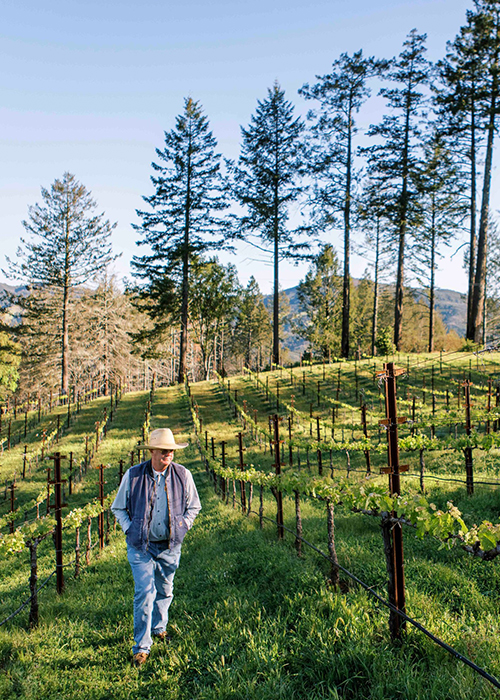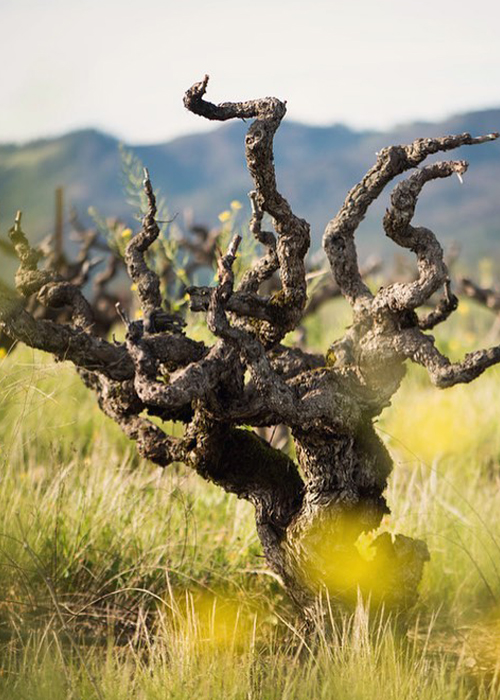In 2015, Seth Morgen Long had a barrel that was too sweet. It was the second vintage at his Willamette Valley winery, Morgen Long, where he employs a low-intervention approach. “I could’ve added cultured yeast to get the wine dry, but I was sticking to my ethics,” he says. Instead, he turned to a method traditionally used in Spain and Portugal. He blended vintages, topping the stuck barrel with some drier juice from 2014. It was maverick for a winemaker focused on single-vintage Chardonnay, but it worked. When his 2016 vintage was complete, he added some of that, too. Long was creating an American solera.
Common in port and sherry, solera successively borrows wine from younger barrels, which are racked into the next-older barrels. Bottles are filled from the oldest barrels, which accumulate many vintages as they’re topped up over time. Seven years later, Long’s solera has doubled in size. “It’s different from my vintage wines,” he says, “but I love it as a way of ensuring that my clients have something unique.”
With the nutty, creamy character of older wine overlaid by younger wine’s snap, it’s an intriguing success. But ask Long if his multi-vintage creation is sustainable, and he demurs. “It’s a stretch to say I did this for sustainability, unless we’re talking about it being not wasteful with my stewarding of a farmer’s work into a product that sustains a small business,” he says.
Don’t miss a drop!
Get the latest in beer, wine, and cocktail culture sent straight to your inbox.
In fact, that is what we’re talking about: Take a problem wine, and instead of dumping it, fix it without additives, and turn it into something that excites consumers? That’s sustainability. For the increasing number of American producers making them, multi-vintage wines can counteract the unsustainable aspects of vintage-driven production –– particularly as climate change brings more extremes.

No Waste, No Chemicals
Toxic filtration to fix volatile acidity, stabilizers to deal with Brettanomyces. “When approaching problem-solving with a vintage mindset, many winemakers default to technology,” observes Hiyu Wine Farm co-owner Nate Ready. “The older way is just blending.” He points to Champagne’s history of adding older reserves to non-vintage wines to ensure annual consistency.
At Ready’s multi-use, biodynamic estate in Oregon’s Hood River Valley, wines like his Columbia Valley Red III, a textured blend of three vintages, fit the sustainable format. “We explore all the ways of looking at presenting the land. Not working with vintages is a way of altering perspective,” he says.
Multi-vintage bottlings have also helped Ready steward his crop during wildfire years like 2020. “Wineries were throwing wine away or not honoring contracts, which resulted in people losing vineyards,” he says. But Ready had a solution for smoke taint. “Blending harnesses those grapes without losing them. You’re planning how those flavors can relate to material from other vintages, so you can place them in a delicious presentation.”
Made using a solera of Chardonnay, Pinot Gris, and Pinot Noir from 2015 through 2020, Ready’s velvety, floral Moon Hill Farm II is such a bottling. “The multi-vintage wines end up being our best. They [spend] longer in the barrel, and there’s more work in their care.” They’re as much a business decision as a philosophical and stylistic one. “It’s about not having one’s eggs in one basket,” he says. “We had low yields recently, and the multi-vintage wines have been a part of making that more sustainable.”
Hiyu makes 3,000 cases a year; Wild Arc Farm, in New York’s Hudson Valley, is even smaller. In 2019, it was hit with late-season rains, which caused most of its Marquette grapes to rot. The next year, the fruit ripened so early that birds hadn’t migrated yet, and they ravaged it –– but Wild Arc had an order to fill from Patagonia Provisions. “We couldn’t make enough wines for us and Patagonia, so we blended vintages,” says Wild Arc co-owner Todd Cavallo.
Supporting Farmers, Sustaining Farmland
At Gamble Family Vineyards, Tom Gamble has long made high-end Napa Valley Cabernet. But with his new, multi-vintage brand The Mill Keeper, he’s trying to provide “reliability at an approachable price.” Informed by focus groups with Millennial consumers, he’s priced his new Cabernet and Chardonnay relatively gently and made them fruit-forward and fresh. Financial sense aside, it was Gamble’s aversion to waste that served as the core impetus to blend vintages. Green harvest, in which less-ripe fruit is pruned from vines to concentrate energy in the remaining grapes, is common in Napa; Gamble thought there must be a use for the dropped fruit. “The birds and coyotes eat it, so why not have an adventure with it?” he says. Gamble’s winemaker Jim Close found out that Sonoma’s larger Kunde Family Winery had a process in place to deal with its damaged fruit that he could use for the green harvest, so he vinified the grapes there, where their juice could be efficiently separated from their tart skins and tannic seeds.

Blended across vintages for consistency and stored in tanks for bottling on demand, the green-harvest wine is now augmented by grapes purchased from growers in Sonoma, Solano, Lake, and Mendocino Counties who have “vineyards past their heyday.” Gamble quotes from a song by Nathan and the Zydeco Cha-Chas: “‘Everything on the hog is good.’ You don’t let anything go to waste. You can keep vines that aren’t wonderful but are still making fruit. Until taken out, they sequester carbon.”
Unsurprisingly, he plans to measure The Mill Keeper’s carbon capture. Meanwhile, he’s supporting family farmers, as a regular customer like Gamble “allows these folks to keep farming and get the economic return. There’s a sustainability component in that.” Though the grapes he buys are conventionally farmed, as he establishes The Mill Keeper as a steady source of income, he can “ask for more” from growers, encouraging sustainable farming.
Holistic, Natural Approach
“Nature is unpredictable, spontaneous, free-flowing. There’s a fluidity that arises from multi-vintage wines that speaks to nature itself,” says Fable Farm Fermentory co-owner Jon Piana. At their Vermont farm, Piana and his brother Christopher take the concept to its outer limits, crafting multi-vintage co-ferments. A bottle they produced for the wine club Viticole included 2015 apple cider, 2016 maple wine and mead, and 2019 wine made from a cold-hardy hybrid white grape, La Crescent.
“We do it for economic reasons and creative reasons. It helps us not have to age everything, so we can make room for each year’s harvest,” Piana explains.” We find a way to use everything, and there’s less waste. And it’s one way of bringing out the qualities of elevage that we enjoy — rounded, smooth, buttery, integrated — and mixing it with younger wine that’s more austere, and you get better wine.”
Financial, practical, and qualitative sustainability — That sums up the holistic promise of multi-vintage wines. “As in any community,” says Piana, “when youth and elders combine, they make magic.”
This story is a part of VP Pro, our free content platform and newsletter for the drinks industry, covering wine, beer, and liquor — and beyond. Sign up for VP Pro now!


